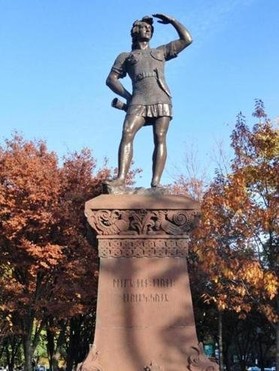Leif Erikson Memorial
Introduction
Text-to-speech Audio
Images
Leif Erikson Memorial Statue found on the Commonwealth Avenue Mall

Backstory and Context
Text-to-speech Audio
In 1887, the Leif Erikson Memorial statue was unveiled on Commonwealth Avenue Mall in Boston Massachusetts(1). Made by sculptor Anne Whitney and paid for by Harvard chemistry professor Eben Norton Horsford, the memorial depicts the bronze figure of a young Leif Erikson upon a red sandstone pedestal, covered in chainmail with a knife at his hip, facing west(2). Though striking, the memorial seems to commemorate an event that did not happen.
Erikson was an explorer from what is now Iceland. Some academics believe that he went on a voyage around the year 1000 A.D. and landed in several spots across the North American East coast(3). Several places were believed to have been landing spots for Erikson, including modern day Newfoundland(4). There was a smaller group of scholars, including Dutch academic Carl Christian Rafn, who believed the Vikings Erikson led made it down to New England (5). An even smaller number of people believed that Leif Erikson stopped briefly at Cape Cod and then landed more permanently in the Boston area, and then set up a city called Norumbega (a name from an old Icelandic map) along the Charles River with a homestead in modern day Cambridge(6). If this were true, it would mean that the Vikings were the first Europeans to settle America, hundreds of years before Christopher Columbus would be credited with its ‘discovery’.
These suppositions that Leif Erikson made it to Boston and set up a society here are in many ways problematic. Professor Eben Norton Horsford, an admirer of Rafn’s writings, was one of the people who believed in the idea when it was popular in the mid-1800’s(7). He had made his fortune with the invention of double acting baking soda(8). A chemist and a professor by trade, he also considered himself a sort of anthropologist or archaeologist despite having no training or authority in the fields(9). He had a particular interest in Vikings and the possibility that they might have set up a sort of society in the Boston area(10). He put a considerable amount of time and effort into comparing theories and reading about the subject(11). He even thought he had discovered the final remains of Erikson’s home while he lived here, a smooth stone foundation in Cambridge, coincidentally down the street from Horsford’s own home and littered with colonial artifacts that he dismissed as trash, denying the stone foundation could possibly be colonial in origin(12). He paid for the space and set up a plaque to commemorate Erikson’s alleged house(13).
Horsford, however, did not have any substantial proof that could be confirmed by other scholars. The stone foundation he found was most likely from the colonial period(14). The proximity of the alleged site to Horsford’s own home did not strengthen his case. To this day, there has been no indisputable evidence that Leif Erikson or any Vikings had visited or lived in Boston (15). That did not, however, stop Horsford from commemorating his own ‘discoveries’ and convictions. With his own funds he set up the plaque for Erikson’s home and the bronze statue of Leif Erikson on the Commonwealth Avenue Mall(16). While there is evidence that Leif Erikson visited North America, there is nothing that indicates he was ever in Boston, which means that his westward facing statue has been commemorating an event that never happened (17). However, while an actual visit from the Vikings may not have occurred, the statue is still a testimony to a chapter in Boston’s history when people believed that they had. The statue is more of a memorial to that mid-nineteenth century belief.Sources
1 Greis, Gloria. “Vikings on the Charles.” Needham Historical Society Needham Historical Society, Needham Massachusetts 02492, Needham Historical Society, needhamhistory.org/features/articles/vikings/.
2 Klein,
Christopher. “Uncovering New England’s Viking Connections.” The Boston Globe,
23 Nov. 2013, www.bostonglobe.com/lifestyle/travel/2013/11/23/uncovering-new-england-viking-connections/JhxUdp7xvwZK8DjxqQ9cFO/story.html.
3 Klein, Christopher. “Uncovering New England’s Viking Connections.” The Boston Globe, 23 Nov. 2013, www.bostonglobe.com/lifestyle/travel/2013/11/23/uncovering-new-england-viking-connections/JhxUdp7xvwZK8DjxqQ9cFO/story.html.
4 MARTIN, CYRUS, J. "THE VIKINGS IN AMERICA." St.Nicholas; an Illustrated Magazine for Young Folks (1873-1907) 07 1876: 585. ProQuest. Web. 16 Oct. 2017 .
5 Klein, Christopher. “Uncovering New England’s Viking Connections.” The Boston Globe, 23 Nov. 2013, www.bostonglobe.com/lifestyle/travel/2013/11/23/uncovering-new-england-viking-connections/JhxUdp7xvwZK8DjxqQ9cFO/story.html.
6 Greis, Gloria. “Vikings on the Charles.” Needham Historical Society Needham Historical Society, Needham Massachusetts 02492, Needham Historical Society, needhamhistory.org/features/articles/vikings/.
7 Shipley, J. (1889, November 01). A VIKING MONUMENT. The Antiquary, p. 229.
8 Klein, Christopher. “Uncovering New England’s Viking Connections.” The Boston Globe, 23 Nov. 2013, www.bostonglobe.com/lifestyle/travel/2013/11/23/uncovering-new-england-viking-connections/JhxUdp7xvwZK8DjxqQ9cFO/story.html.
9 Greis, Gloria. “Vikings on the Charles.” Needham Historical Society Needham Historical Society, Needham Massachusetts 02492, Needham Historical Society, needhamhistory.org/features/articles/vikings/.
10 Greis, Gloria. “Vikings on the Charles.” Needham Historical Society Needham Historical Society, Needham Massachusetts 02492, Needham Historical Society, needhamhistory.org/features/articles/vikings/.
11 Shipley, J. (1889, November 01). A VIKING MONUMENT. The Antiquary, p. 229.
12 Greis, Gloria. “Vikings on the Charles.” Needham Historical Society Needham Historical Society, Needham Massachusetts 02492, Needham Historical Society, needhamhistory.org/features/articles/vikings/.
13 Greis, Gloria. “Vikings on the Charles.” Needham Historical Society Needham Historical Society, Needham Massachusetts 02492, Needham Historical Society, needhamhistory.org/features/articles/vikings/.
14 Greis, Gloria. “Vikings on the Charles.” Needham Historical Society Needham Historical Society, Needham Massachusetts 02492, Needham Historical Society, needhamhistory.org/features/articles/vikings/.
15 MARTIN, CYRUS, J. "THE VIKINGS IN AMERICA." St.Nicholas;
an Illustrated Magazine for Young Folks (1873-1907) 07 1876: 585. ProQuest.
Web. 16 Oct. 2017 .
16 Klein, Christopher. “Uncovering New England’s Viking Connections.” The Boston Globe, 23 Nov. 2013, www.bostonglobe.com/lifestyle/travel/2013/11/23/uncovering-new-england-viking-connections/JhxUdp7xvwZK8DjxqQ9cFO/story.html.
17 Klein, Christopher. “Uncovering New England’s Viking Connections.” The Boston Globe, 23 Nov. 2013, www.bostonglobe.com/lifestyle/travel/2013/11/23/uncovering-new-england-viking-connections/JhxUdp7xvwZK8DjxqQ9cFO/story.html.
